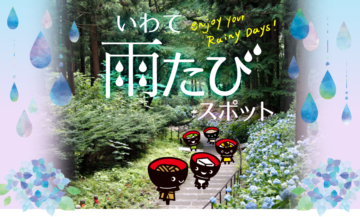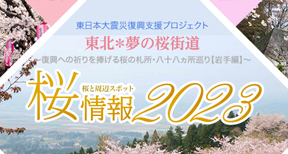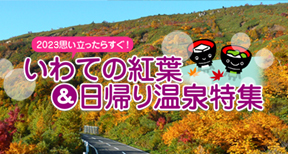
INDEX
- (Northern Prefecture) ① Nakano Shirataki/Otani Onsen (Hirono Town)
- (Northern part of the prefecture) ② Kuji City
- (Northern part of the prefecture) ③ Ichinohe town
- (Northern part of the prefecture) ④Ninohe City
- (Central Prefecture) ⑤Hachimantai City
- (Central Prefecture) ⑥ Shizukuishi Town
- ⑧Morioka City
- (South of the prefecture) ⑨Kitakami City
- (South of the prefecture) ⑩ Nishiwaga Town
- (South of the prefecture) ⑪Hiraizumi Town
- (South of the prefecture) ⑫Ichinoseki City
- (South of the prefecture) ⑬Kamaishi City/Ofunato City

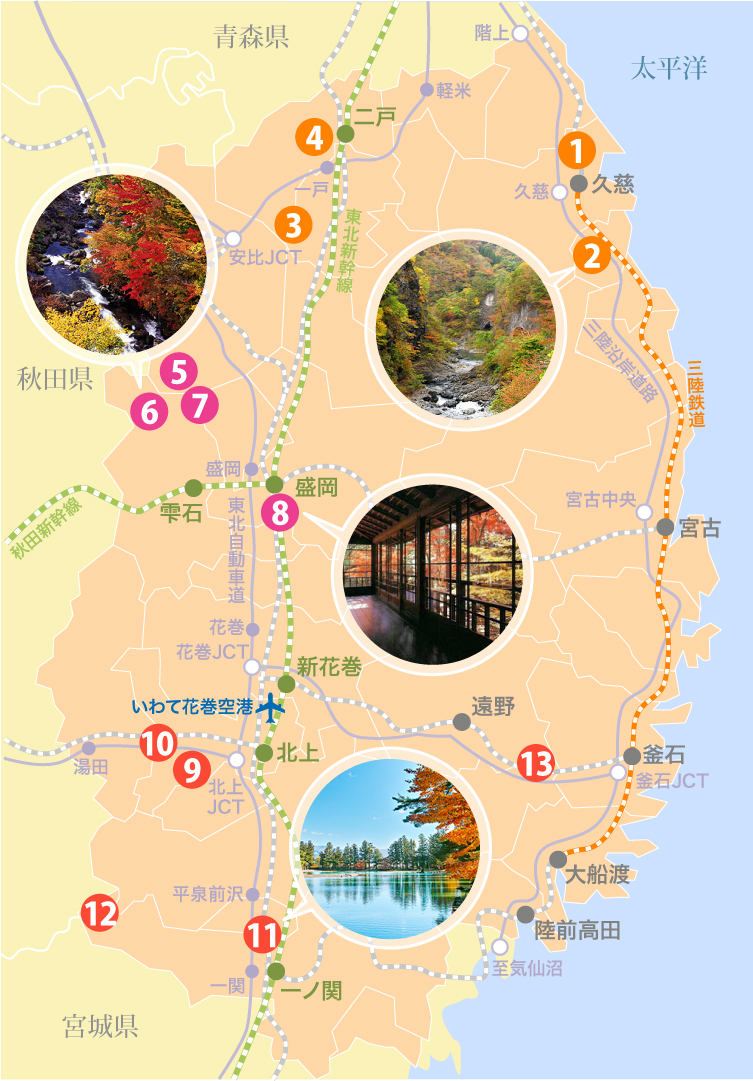
(Northern Prefecture) ① Nakano Shirataki/Otani Onsen (Hirono Town)
Nakano Shirataki Nakano Shirataki
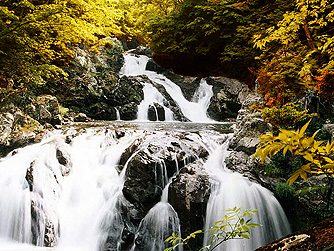
Nakano Shirataki is a two-tiered waterfall that spans the Takaie River, and the surrounding trees are beautiful in every season, making it a waterfall that is both dynamic and graceful. To reach the waterfall, you will have to walk for about 10 minutes down the promenade from Shirataki Shrine, which enshrines Shirataki Daimyojin, so please wear shoes and clothes that are comfortable for walking.
There is also a promenade leading from the waterfall to the sea, where you can enjoy hiking.
Otani Onsen Oyaonsen
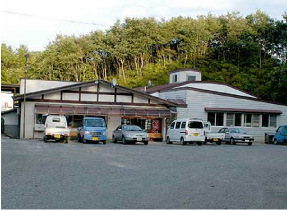
Otani Onsen, which stands quietly in the middle of a natural mountain about 10 kilometers up a mountain road from National Route 45, has a reputation for having one of the highest radon concentrations in Iwate Prefecture. This hot spring has been loved by locals for a long time as a public bath, and is also popular with tourists and spa visitors from inside and outside the prefecture.
(Northern part of the prefecture) ② Kuji City
Osanai Mountain Stream
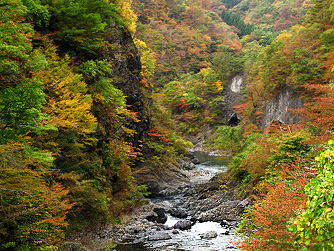
Photo provided by: Shinyamane Onsen Beppin no Yu
A valley located upstream of the Osanai River, a tributary of the Kuji River. The cliffs, which are around 80 meters high, extend for approximately 3 km, and are attractive for their vivid colors in each season.The fresh greenery in spring and the autumn leaves in autumn create a wonderful contrast with the white rock surface. A walking path has been established from the pavilion parking lot of Taki Dam on the upper reaches of the Osanai River.
Shinyamane Onsen Shinyamane Onsen
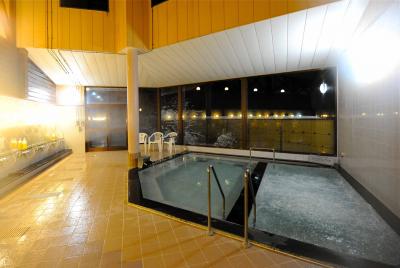
A quiet mountain hot spring located in Yamane-cho, Kuji City. The spring quality is alkaline simple hot spring. The alkalinity is PH10.8, leaving your skin smooth and smooth. Surrounded by nature, you can enjoy bathing while looking at fresh greenery and autumn leaves from the open-air bath.
(Northern part of the prefecture) ③ Ichinohe town
Okunakayama Kogen
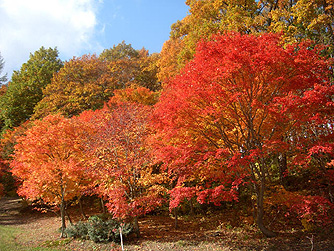
An accommodation facility with a hot spring located 700 meters up the mountainside of Mt. Nishidake. There are plenty of leisure facilities such as a sightseeing observatory, fishing pond, playground equipment square, and ski resort. You can enjoy it with your family all year round.
Okunakayama Kogen Onsen
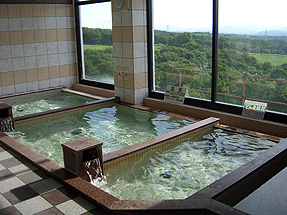
A hot spring resort where you can enjoy two hot springs: Asashu no Yu and Kousei no Yu. The hotel is fully equipped with facilities perfect for those who want to fully enjoy the hot springs, such as saunas, cold baths, open-air baths, and electric baths. The quality of the spring water is sodium-hydrogen carbonate, making it especially popular among women as it leaves their skin smooth after bathing.
(Northern part of the prefecture) ④Ninohe City
Masenkyo Gorge
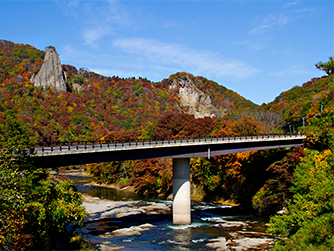
Masen Gorge, designated as an Iwate Prefectural Natural Park, is a scenic spot that represents Ninohe City. The scenery is beautiful in all seasons, and the gigantic rocks “Otokamiiwa” and “Megamiiwa” that tower at the confluence of the Mabuchi River and the Appi River are the largest of the Meotoiwa Rocks in Japan. You can see the bright deciduous trees along the mountain stream from near Masen Ohashi Bridge, and if you go to the observation deck above Ojiniwa Rock, you can enjoy the magnificent view of the valley.
Kindaichi Onsenkyo Kindaichi Onsenkyo

Kindaichi Onsenkyo is located about 20 minutes by car from Masenkyo Gorge. This is a historic hot spring said to have been discovered in 1626, and was once known as the “Samurai Hot Spring” because it was a spa for the Nanbu domain. The spring quality is a simple spring. It has a reputation for being less irritating and soft on the skin. There is also an inn known as a Zashikiwarashi inn.
(Central Prefecture) ⑤Hachimantai City
Hachimantai/Mori Ohashi Dish Towel near Morino Ohashi Bridge
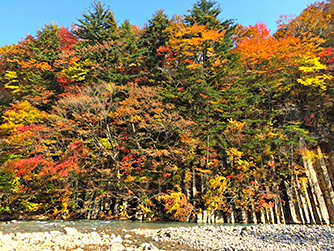
The area around Hachimantai’s Mori no Ohashi Bridge is famous for being one of the prefecture’s best spots for viewing autumn leaves.
You can enjoy the spectacular view from the top of the bridge or while walking along the nearby walking path.
The colors usually start to change in late September near the top of Hachimantai, but the best time to see them is around mid-October near the base of Mori no Ohashi and Kenmin no Mori.
During the autumn foliage season, the roads are very crowded. If you would like to take a tour, please use the Kenmin no Mori parking lot.
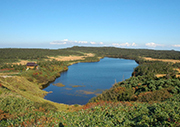
Matsukawa Onsen Matsukawa Onsen
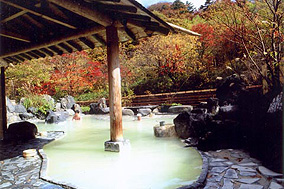
Matsukawa Onsen is located in front of the Jukai Line from Mori-no-Ohashi Bridge. It is a historical hot spring that opened about 260 years ago and is full of the atmosphere of a hidden hot spring. Matsukawaso has a large open-air bath along the mountain stream, where you can soak in the hot springs while enjoying the autumn leaves. The milky white water is said to have a skin-beautifying effect and is full of emotion.
(Central Prefecture) ⑥ Shizukuishi Town
Kakkonda Valley and Torigoe Falls
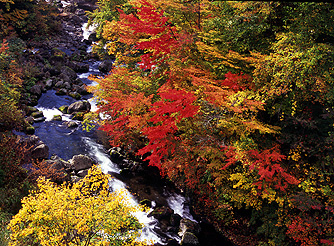
The valley at the upper reaches of the Kakoneda River, which occupies a part of Towada-Hachimantai National Park, is home to a variety of broad-leaved trees including primeval beech forests, and you can see beautiful autumn leaves in the fall. The main attraction of Kakkonda Valley is Torigoe Falls. The basin of the waterfall is filled with deep green water, and above the waterfall, steam from the surrounding geothermal heat rises from all over the ground, creating a beautiful contrast between the yellow of the beech and the red and orange of the maple during the autumn leaves season. .
It is closed to vehicles during the winter (late November to late April).
Minami Arine Onsen Minami Arine Onsen
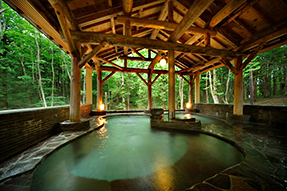
You can enjoy nature right in front of you from the “Yukotan no Mori” open-air bath with a panoramic view of Mt. Iwate and the open-air bath in the forest.
The entire facility is filled with the warmth of wood, making your heart feel at ease.
Inukurayama Inukurayama

Mt. Inukura is one of the Mt. Iwate climbing routes that you pass through on the Amihari course. If you use the lift at Amihari Ski Resort, which operates from summer to autumn, you can travel to an altitude of around 1.300km in one go. There are three lifts, and it takes a 15-minute walk from the final point to reach the summit of Mt. Inukura. You can enjoy a 360-degree view from the top of the mountain, and during the autumn leaves season, you can enjoy the mountain range dyed in red and yellow.
Amihari Onsen Amihari Onsen
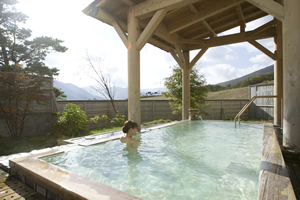
Amihari Onsen is a famous hot spring that was discovered 1300 years ago. In addition to Kyukamura Iwate Amihari Onsen, there are day-trip bathing facilities that are used not only by locals but also by skiers and mountain climbers.
⑧Morioka City
Looks like Namshoso
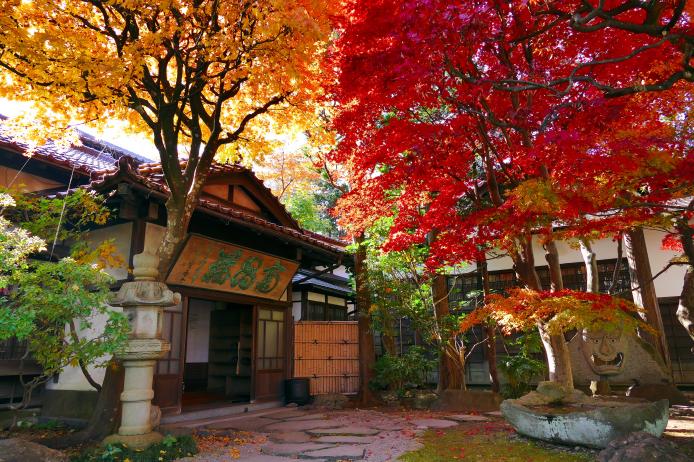
Namsho-so was built as a residence by Yasugoro Yorikawa, a businessman from Morioka City, in 1888, and the garden was designated as a protected garden by Morioka City over several years. It remains today as a Meiji residence and famous garden. The garden offers beautiful scenery in all seasons, but especially during the autumn leaves season, it is known as a famous place and is loved by many people.
Autumn leaves garden illumination Wednesday, November 8, 2023 – Sunday, November 12, 2023 (lights on at 16:30, special opening until 19:30)
Morioka Tsunagi Onsen Morioka Tsunagi Onsen

Tsunagi Onsen is Morioka’s inner parlor. It is located about 30 minutes by car from Morioka city and is lined with hotels and Japanese-style inns.
There are six hot springs, and the amount of hot water is abundant, and the spring quality is simple sulfur spring with a highly alkaline pH of 8.7 to 9.5, and is reputed to leave your skin smooth.
(South of the prefecture) ⑨Kitakami City
Summer oil plateau getougen
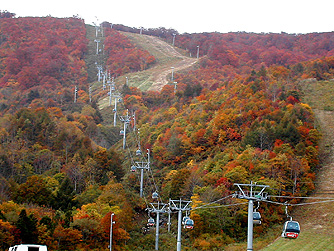
Natsuyu Kogen is known as the largest full-fledged ski resort in the southern part of the prefecture. You can also ride the gondola to the top of the ski resort and enjoy a panoramic view. The Natsuyu Kogen Autumn Foliage Festival is held every October, and there are many events scheduled, including gondola rides where you can enjoy a relaxing view of the autumn leaves, autumn leaves trekking, and a handicraft market.
[Natsuyu Kogen Autumn Foliage Festival] October 7th (Sat) – 9th (Monday/holiday), 14th (Sat), 15th (Sun) *Gondola rides also available on 21st (Sat) and 22nd (Sun) It is done.
◆ View the homepage Natsuyu Kogen Autumn Foliage Festival
Natsuyu Kogen Onsen Getou Kogen Onsen
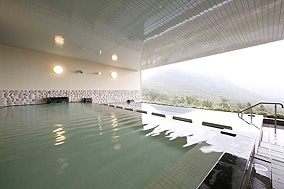
(South of the prefecture) ⑩ Nishiwaga Town
Kinshuko Kinshuko

Lake Kinshu is a reservoir of Yuda Dam built in the middle reaches of the Waga River. The seasonal scenery reflected on the surface of the lake is beautiful, and you can enjoy a panoramic view of the lake from Kinshuko Lakeside Park. During the autumn foliage season, you can enjoy the vivid and beautiful scenery of Lake Kinshu, as the name suggests. Additionally, the lake stretches along the JR Kitakami Line and National Route 107, making it an ideal area for train travel and driving.
Kawajiri Onsen Hot Yuda Kawajiri Onsen Hot Yuda
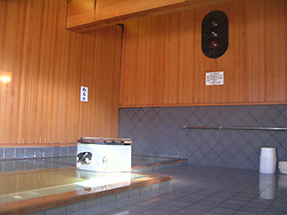
“Hotto Yuda” is a station building with a hot spring, which is rare in Japan. The facility is a rustic building that makes use of wood, and is unique with a clock tower on top of a tongari roof and decorations that resemble the town’s bird, the Yamadori. There is a traffic light in the public bath, which uses blue, yellow, and red colors to let you know when a train is approaching.
(South of the prefecture) ⑪Hiraizumi Town
Motsuji Temple
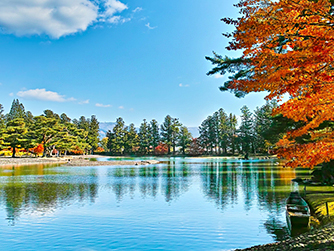
This temple was constructed by Motohira, the second generation of the Oshu Fujiwara clan, in the mid-12th century. The Jodo garden and the remains of a Heian period temple have been designated by the national government as both a special historic site and a special scenic spot.
The Jodo garden, centered around Oizumi Pond, offers a variety of scenery to enjoy throughout the four seasons, and the beautiful landscape is a must-see even during the fall foliage season.
[Autumn Fujiwara Festival] November 1st (Wednesday) to November 3rd (Friday/Holiday)
◆ View the homepage Hiraizumi Town Tourism Association
Eternal hot spring Hiraizumi Onsen
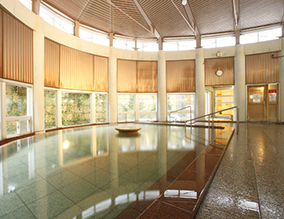
The warm interior, made with plenty of wood, will give you a relaxing moment.
(South of the prefecture) ⑫Ichinoseki City
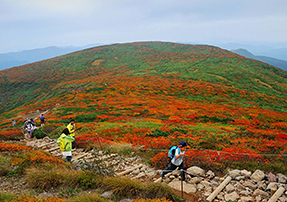
Also called Mt. Sugawa in Iwate Prefecture, it is the main peak of Kurikoma Quasi-National Park and is 1,626m above sea level. Climbing courses lead from Iwate, Akita, and Miyagi prefectures, and those on the Iwate side climb from the Sugawa Onsen trailhead. You can enjoy the scenery of each season from the opening of the mountain in mid-May to the closing of the mountain in November. From spring to summer, the alpine plants of Kurikoma, known as the “100 Famous Mountains of Flowers,” are in full bloom, and from the end of September the fiery autumn leaves are a sight to behold. Autumn is an especially busy season, with many people visiting from all over the country for mountain climbing and sightseeing.
*Please be aware that there will be traffic congestion during the autumn foliage season. (National Route 342 is closed in the winter from mid-November to early May.)
*Parts of the “Kurikomayama Sugawa Course” are prohibited from entering.Click here for details ⇒ [Iwate Prefecture Nature Conservation Division HP]

Dog Blog★Climbing Edition | Wanko Blog★Rice/Hot Spring Edition
Sukawa Kogen Onsen
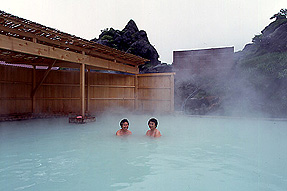
Sugawa Onsen, located at the northern foot of Mt. Kurikoma, is a hot spring with plenty of hot water. It is a highly acidic alum green spring that is rare in Japan, and is said to be effective against gastrointestinal diseases, women’s diseases, respiratory diseases, etc., and has been popular as a therapeutic hot spring since ancient times. Taking advantage of the abundant amount of hot water, there is a large public bath, a 1000-person bath, a large open-air bath, and large and small indoor baths. In particular, in the large open-air bath, you are sure to be immersed in an open feeling in the middle of nature!
During the business period from May to November, it is crowded with many visitors as a base for climbing and hiking Mt. Sugawa.
There is a footbath below the source that can be used free of charge to soothe the fatigue of mountain climbing and excursions.
(South of the prefecture) ⑬Kamaishi City/Ofunato City
Sennintouge Sennintoge
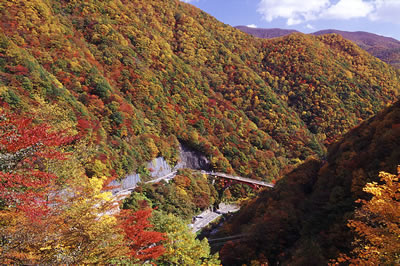
A spectacular autumn foliage viewing spot located on the border between Tono and Kamaishi. There are various theories about the origin of the name, but it is said that it was given this name because a hermit once lived there.
The new Sennintoge Road opened in March 2007, but the old road on the Kamaishi side is in a loop, and the 887m high green pass offers a spectacular view of colorful autumn leaves in the fall. Masu.
Goyo Onsen “Rhodanage no Yukko” Goyou Onsen Rhododendron Yukko

A day-trip bathing facility surrounded by nature at the foot of Sennin Pass, where wild Japanese deer live. The first natural hot spring on the Sanriku coast. It is named “Rododendron Hot Spring” after the rhododendron flowers that decorate Sennintoge in early summer. The hot spring has an abundant amount of hot water and is alkaline simple hot spring, and is reputed to leave your skin smooth after bathing.




